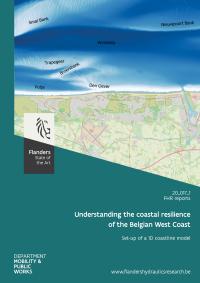Gedaan met laden. U bevindt zich op: Understanding the coastal resilience of the Belgian West Coast. Set-up of a 1D coastline model
Understanding the coastal resilience of the Belgian West Coast. Set-up of a 1D coastline model
The CREST project (Monbaliu et al., 2020) showed that topo-bathymetric monitoring carried out in the past 30 years revealed that the amount of sand in the active zone of the Belgian West Coast increased substantially. Correcting for sand works carried out, the rate of natural feeding of the area was estimated to be 10 mm/year, which is significantly more than the local sea level rise rate of 2 to 3 mm/year. One concludes that this coastal zone, with a length of ca. 16 km, has shown a natural resilience against sea level rise. The question remains which processes govern this behavior and where natural input of sand to the system occurs.
Using available coastal monitoring data as well as a state of the art sand transport model for the Belgian coast, it was revealed that natural processes drive complex transport patterns in the channel and the nearshore bank, resulting in a cross-shore natural feeding from off-shore to the coastline. The spatial distribution of this cross-shore natural feeding is determined by the existence of a channel – sand bank system.
The outcome of this research is a conceptual model for the large scale sand exchange in the study area which is implemented in a 1D coastline model. The most important element in these models is the cross-shore natural feeding of the active zone via a shoreface connected ridge amounting to 95,000 m3/year in the period 2000-2020.

Lees de publicatie
- Publicatiedatum
- December 2022
- Publicatietype
- Rapport
- Thema's
- Scheepvaart en havens
- Auteur(s)
- A. Dujardin, A.L. Montreuil, K. Trouw, D. Dan, B. De Maerschalck , R. Houthuys, T. Verwaest
- Reeks
- FHR reports 20_017_1